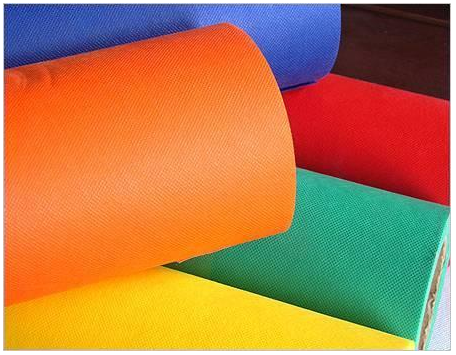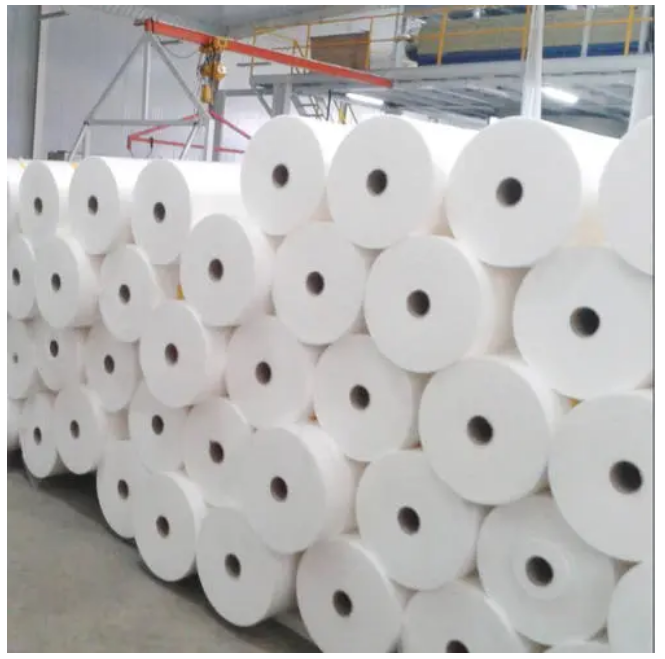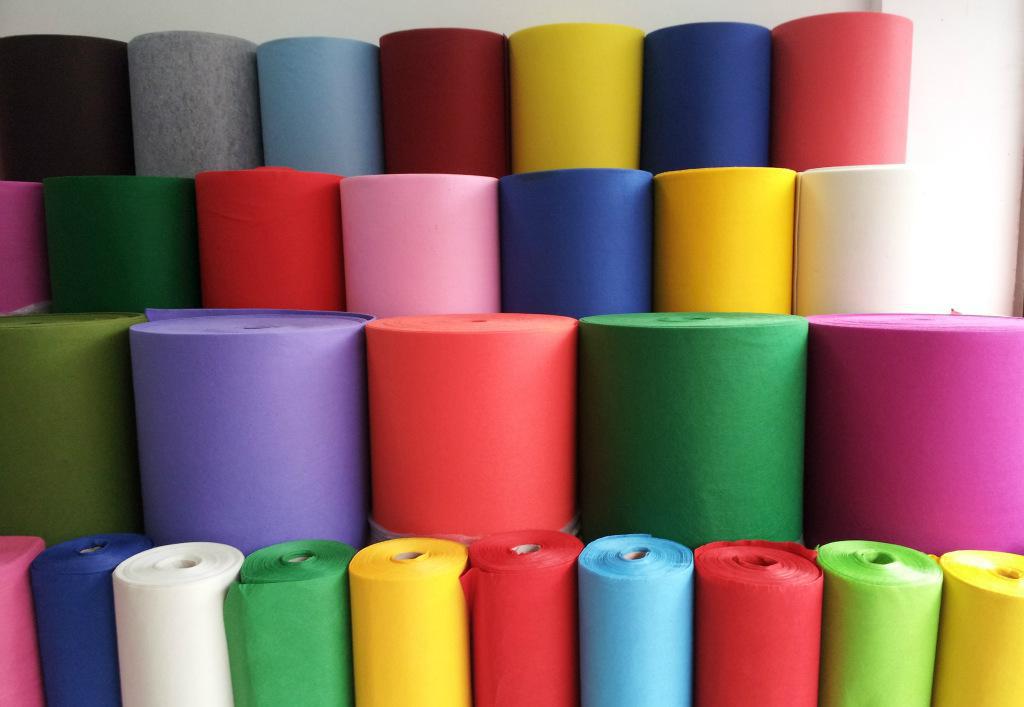Contents
Nonwoven Fabric Introduction

Non-woven fabric, also known as non-woven fabric, needle-punched cotton, needle-punched non-woven fabric, etc.,
It is produced by polyester fiber, polyester fiber (abbreviated as: PET) material, and made by needle-punching process, which can make different thickness, feel, hardness, etc.
Non-woven fabric has the characteristics of moisture-proof, breathable, flexible, light, flame retardant, non-toxic and tasteless, low price, recyclable, etc..
It can be used in different industries, such as sound insulation, heat insulation, electric heaters, masks, clothing, medical, filling materials, etc.
1.Non-woven characteristics
Non-woven fabric has no warp and weft threads, is very easy to cut and sew, and is light and easy to shape, making it popular among craft enthusiasts.
Because it is a fabric formed without spinning and weaving, it is only a textile short fibers or filaments arranged in a directional or random way to form a fiber network structure, and then reinforced by mechanical, thermal or chemical methods.
It is not made of one by one yarn interwoven and braided together, but the fibers are directly bonded together by physical methods, so when you get the sticky weigh in your clothes, you will find that it is impossible to draw a single thread.
Non-woven fabric breaks through the traditional textile principle and has the characteristics of short process flow, fast production rate, high yield, low cost, wide application and many sources of raw materials.
Relationship between non-wovens and spunbond fabrics
Spunbond Non-woven Fabric

Spunbond and nonwoven fabrics are subordinate to each other. There are many production processes for the manufacture of nonwoven fabrics,
among which spunbond is one of the nonwoven production processes (including spunbond, meltblown, hot-rolled and hydroentanglement,
most of the nonwoven fabrics on the market now are produced by spunbond)
According to the composition of nonwoven fabrics, there are polyester, polypropylene, nylon, spandex, acrylic, etc.;
different compositions will have very different styles of nonwoven fabrics.
As for spunbond cloth, it usually refers to polyester spunbond and polypropylene spunbond;
and the styles of these two cloths are very close to each other and can only be distinguished by high-temperature testing.
Nonwoven fabric is a kind of nonwoven fabric, which is a non-woven fabric formed by directly using polymer slices, short fibers or filaments to form fibers into a web by airflow or machinery,
then by hydroentanglement, needling, or hot rolling reinforcement, and finally by finishing.
With soft, breathable, and flat structure of new fiber products, the advantage is that it does not produce fiber chips, strong, durable, silky soft, but also a kind of reinforcing material,
and there is the feeling of cotton, and compared with cotton woven products, non-woven bags are easy to form, and the cost is cheap.

2. Advantages of non-woven fabrics.
1. Lightweight: polypropylene resin is the main raw material, the specific gravity is only 0.9, only three-fifths of cotton, with fluffy, feel good.
2. Softness: made of fine fibers (2-3D), lightly dotted hot melt bonding molding. The finished product is moderately soft and has a comfortable feeling.
Polypropylene non-woven
Polypropylene non-woven fabric
3. Water repellence and breathability: Polypropylene slices do not absorb water, and the water content is zero, so the finished product has good water repellence,
and is composed of 100% fibers with porosity and good breathability.
4. can purify the air, using the advantages of small pores to keep bacteria and viruses out of the door.
5. Non-toxic, non-irritating: the product is produced with FDA food-grade raw materials, does not contain other chemical ingredients,
stable performance, non-toxic, odorless, does not irritate the skin.
6. Antibacterial, chemical resistance: polypropylene is a chemically blunt substance, not insects, and can isolate the presence of bacteria and insects within the liquid erosion;
antibacterial, alkali corrosion, finished products do not affect the strength due to erosion.
7. Antibacterial properties. The product has the water pulling, not mold, and can isolate the existence of bacteria and insects in the liquid erosion, not mold moth.

3. Non-woven disadvantages.
1. Less strength and durability compared to textile fabrics.
2. It cannot be washed like other fabrics.
3. The fibers are arranged in a certain direction, so it is easy to split from a right angle, etc.
Therefore, the improvement of the production method is mainly focused on the improvement of the prevention of splitting.

4. Non-woven maintenance
Non-woven fabric in the maintenance and collection should pay attention to the following points.
1, to keep clean, change often, to prevent moth breeding.
2. When storing in new seasons, it should be washed, ironed, dried and sealed in a plastic bag and placed flat in the closet.
Pay attention to shade, to prevent fading. Ventilation, dust removal and dampness should be frequent, not exposed to the sun.
The closet should be put into the anti-mildew, anti-moth tablets, so as to avoid the moisture of cashmere products mold insects.
3, inside wear with its matching outerwear lining to be smooth, pockets are not loaded with hard objects such as pens, key bags, cell phones, etc.,
to avoid local rubbing ball. Outside wear to minimize friction with hard objects (such as sofa back, armrests, desktop) and hooking.
Wearing time is not easy too long, about 5 days shall stop wearing or change wearing so that clothing to restore elasticity, so as not to damage the fiber fatigue.
4, such as pilling, not strong pull, shall use scissors to cut off the pompoms, so as not to cause unwatchable due to off-line.

5. Non-woven use
Non-woven products are colorful, bright, fashionable, environmentally friendly, widely used, beautiful and generous, with various patterns and styles, and light, environmentally friendly, recyclable,
and internationally recognized as an environmentally friendly product to protect the earth’s ecology.
Suitable for agricultural film, shoes, leather, mattress, mother and child quilt, decoration, chemical, printing, automotive, building materials, furniture and other industries,
and clothing interlining, medical health disposable surgical gowns, masks, caps, bed sheets, hotel disposable tablecloths, beauty, sauna and even today’s fashionable gift bags, boutique bags, shopping bags, advertising bags and so on.
Environmentally friendly products, widely used and economical.
Because of its pearl-like appearance, it is also called pearl canvas.
Non-woven fabrics are made from chemical and plant fibers under the condition of water or air as suspension medium on wet or dry paper copying machine,
although the cloth is not woven so it is called non-woven.
Non-woven fabric is a new generation of environmental protection materials, with the advantages of good strength, breathable and waterproof, environmental protection, flexibility, non-toxic and tasteless, and cheap.

It is a new generation of environmentally friendly materials, with water repellent, breathable, flexible, non-combustible, non-toxic and non-irritating, colorful and other characteristics.
If the material is placed outdoors by natural decomposition, its longest life is only 90 days, placed indoors in 8 years to decompose, burning non-toxic, harmless, so as not to pollute the environment, so environmental protection comes from.
(1) Medical and sanitary non-woven fabrics: surgical gowns, protective clothing, disinfection wraps, masks, diapers, civil wipes, wiping cloths, wet face towels, magic towels, soft towel rolls, beauty products, sanitary napkins, sanitary pads, and disposable sanitary cloths, etc.
(2) Non-woven fabrics for home decoration: wall coverings, tablecloths, bedsheets, bedspreads, etc.
Non-woven products are colorful, bright, fashionable, environmentally friendly, widely used, beautiful and generous, with various patterns and styles, and light, environmentally friendly, recyclable, and internationally recognized as an environmentally friendly product to protect the earth’s ecology.
Suitable for agricultural film, shoes, leather, mattress, mother and child quilt, decoration, chemical, printing, automotive, building materials, furniture and other industries,
and clothing interlining, medical health disposable surgical gowns, masks, caps, bed sheets, hotel disposable tablecloths, beauty, sauna and even today’s fashionable gift bags, boutique bags, shopping bags, advertising bags and so on.
Environmentally friendly products, widely used and economical. Because of its pearl-like appearance, it is also called pearl canvas.
Non-woven fabrics are made from chemical and plant fibers under the condition of water or air as suspension medium on wet or dry paper copying machine, although the cloth is not woven so it is called non-woven.

Non-woven fabric is a new generation of environmental protection materials, with the advantages of good strength, breathable and waterproof, environmental protection, flexibility, non-toxic and tasteless, and cheap.
It is a new generation of environmentally friendly materials, with water repellent, breathable, flexible, non-combustible, non-toxic and non-irritating, colorful and other characteristics.
If the material is placed outdoors by natural decomposition, its longest life is only 90 days, placed indoors in 8 years to decompose, burning non-toxic, harmless, so as not to pollute the environment, so environmental protection comes from.
(1) Medical and sanitary non-woven fabrics: surgical gowns, protective clothing, disinfection wraps, masks, diapers, civil wipes, wiping cloths, wet face towels, magic towels, soft towel rolls, beauty products, sanitary napkins, sanitary pads, and disposable sanitary cloths, etc.
(2) Non-woven fabrics for home decoration: wall coverings, tablecloths, bedsheets, bedspreads, etc.
(3) Non-woven fabrics for garments: lining, bonding lining, flocking, shaping cotton, various synthetic leather backing, etc.
(4)Non-woven fabric for industrial use; substrate for roofing waterproofing membrane and asphalt shingle, reinforcing material, polishing material, filtering material, insulating material, cement packing bag, geotextile, covering fabric, etc.
(5) Non-woven fabrics for agriculture: crop protection cloth, rice-raising cloth, irrigation cloth, heat preservation curtain, etc.
(6)Other non-woven fabrics: space cotton, heat insulation, and soundproof materials, oil-absorbing felt, cigarette filters, bagged tea bags, shoe materials, etc.
Non-woven fabric for garment

Medical and health care: surgical gowns, caps, hoods, plaster cotton, women’s sanitary napkins, baby diapers, wet face towels, sanitary underwear, dust covers, masks.
Agriculture: harvest cloth, trellis cloth.
Industry: floppy disk liner, speaker cloth, filter material, speaker sound insulation felt, seal ring liner, cable cloth, fiberglass-reinforced towel, industrial wipe, shockproof liner, insulation material, tape baseliner, pipe baseliner, ventilation duct, sand skin cloth.
Packaging: composite cement bags, bag linings, packaging base linings, quilt wool, storage bags, mobile jacquard bag cloth.
Clothing and footwear: garment lining, wadding, toe hard lining, heel lining, underwear, artificial deerskin, synthetic leather, thermal shoe lining, cloth shoe sole lining.
Automobile industry: waste spinning insulation heat felt, anti-vibration felt, headliner, cushion lining, carpet, door lining, car filter core, molding cushion.
Household apparel: sofa lining, carpet, wall coverings, mirror cleaning cloth, tea bags, vacuum cleaner filter bags, shopping bags, printed bed sheets, party covers, upholstery, sleeping bags, dry cleaning and wiping cloths, cleaning cloths, curtains, tablecloths, lampshades,

lamination on the backside of imperial rattan mats.Civil engineering, construction: reinforcement, reinforcing, filtration, linoleum backing, drainage board, roofing waterproof material, railroad, highway, berm, water slope, harbor sound insulation, sewer, heat prevention, separation, drainage.
Other applications: launch vehicle, missile head heatproof cone, tail nozzle throat liner, advanced printing paper, space shuttle heat-resistant tile, map cloth, calendar cloth, artificial cloth, oil painting cloth, etc.

 By Coco Ho
By Coco Ho

